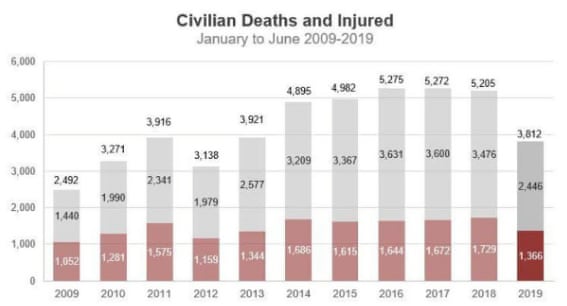By Emma Graham-Harrison
Afghan forces and their international allies killed more civilians in the first half of 2019 than the Taliban and other militant groups, UN figures show, extending a trend that began in the first quarter of the year.
Airstrikes were particularly deadly, and one of the few types of casualty to increase significantly compared with the same period of 2018. Two-fifths of the deaths and injuries from airstrikes were attributed to international forces, the UN said – in effect US airstrikes.
This year is the first time since civilian casualty records started over a decade ago that pro-government forces have caused more deaths than insurgents, raising serious questions about the western mission there.
For years, despite civilian deaths and injuries caused by both sides, the government in Kabul and its allies had been able to point to UN statistics showing that insurgents were the biggest killer of Afghan civilians.
That is no longer the case. Overall the report found 403 civilians were killed by Afghan troops and 314 by their international allies in the first six months of 2019, a total of 717. The Taliban, Islamic State and other militant groups killed 531 civilians.
Afghanistan is facing a critical few weeks, as peace talks with the Taliban enter what many hope will be their final stages, ahead of a presidential election set for the end of September. There have been concerns that both sides have ramped up violence as the peace process got under way, to strengthen their position at the negotiating table.
“Gaining leverage in peace talks should not come at the cost of such carnage on either side,” said Patti Gossman, an associate Asia director at Human Rights Watch.
A deal might not end violence in Afghanistan entirely, however; the UN found that more than 10% of civilian casualties are caused by the regional Isis affiiate, which is not party to the talks.

Civilian deaths and injuries in Afghanistan from 2009-19. (Photo: UN mission in Afghanistan)
Overall casualties were down by nearly a quarter from record levels a year earlier, but civilians were still being killed and maimed at a “shocking and unacceptable” rate, the UN said in its regular report on the protection of civilians.
Airstrikes were particularly deadly, and one of the few types of casualty to increase significantly compared with the same period of 2018. Two-fifths of the deaths and injuries from airstrikes were attributed to international forces, the UN said – in effect US airstrikes.
Although the US officially ended its combat mission in Afghanistan in 2014, it still has special forces on the ground and provides air support to Afghan troops.
The government has repeatedly said the high toll from air attacks is a result of militants hiding among civilians, but international humanitarian law bars the use of disproportionate force.
“The claim that the Taliban use civilians as shields is not an excuse for disproportionate attacks,” Gossman said. “In fact, neither the US nor the Afghan government adequately investigates airstrike deaths, or holds its forces accountable for targeting that causes civilian deaths.”
The Taliban have rejected calls for a ceasefire while peace talks are under way, and have been carrying out near daily operations, mainly targeting security forces.
But militants have also attacked civilians in violation of international law. More than 300 people were killed in violence targeting civilians, including tribal elders, aid workers, religious scholars, mullahs and government officials.
“Parties to the conflict may give differing explanations for recent trends, each designed to justify their own military tactics,” said Richard Bennett, the human rights chief of the UN assistance mission in Afghanistan, which released the report.
There has been no claim of responsibility for an attack on Sunday night that apparently targeted the office of the Afghan president’s running mate and former chief of the intelligence service.
The vice-presidential candidate, Amrullah Saleh, was safely evacuated from the scene of the attack, which left at least 20 people dead and about 50 wounded. Saleh is known for his fierce anti-Taliban stance.



